Without AWD, Kia K5 survives winter wonderland
By John Gilbert
T’was the day before Christmas Eve, and it sticks in my memory because it was perfect time for a blizzard. We were feeling a bit coddled up here in Duluth, Minnesota, which often is the prototypical Great White North by Christmastime, but during the strange year of 2020, we were informed that we had only a total accumulation of two-tenths of an inch of snow, as of December 23.
By chance, two test-drive vehicles had arrived two days earlier, a gigantic and luxurious Cadillac Escalade and a sleek and racy-looking Kia K5 — redesigned to be racier than ever, so racy that the name Optima doesn’t work any more, and Kia has changed it to K5. That sounds more like a model of Rossignol downhill skis, which was also appropriate, it turned out.
When the fellows from Chicago’s press-fleet agency dropped the two vehicles off at myour country home, I nodded toward the K5 and asked, “Is this all-wheel drive?” and one of them said “Yes.” I took a quick little warm-up spin in the K5 and found it handled as well as I’d anticipated, although it felt a little squirmy, as though it might not be all-wheel-drive. Oh well, front-wheel drive with good tires creates a vehicle that can get you through almost anything in the toughest winters. Almost, being the operative word.
On Christmas Eve, a nasty snowstorm hit St. Paul, delaying our older son, Jack, on his venture north to visit us. We’re a couple of hours north of the Twin Cities, and it was 39 degrees at our place, and drIzzling rain. I suggested to my wife, Joan, that it might keep drizzling all day, and she should drive the K5 the short distance to her work. It also was Sapphire Blue, a very neat shade of dark-medium blue. After examining it throughly, I realized the K5 did not have AWD, although it is available this year on the K5, but we both know that FWD with the right tires can handle everything without difficulty. And I could give that Escalade a good wringing out. She did, and said she thought the K5 handled very well.
I tried all sorts of things with the Escalade, but couldn’t find any switch that would engage all-wheel drive, or lock it in 4×4. I got out and checked all four corners and realized that this $100,000 Escalade was loaded with luxury, but did not have AWD!
i had a lot of writing to do that day, but I also realized that the rain was turning to snow, which soon was “really coming down.” Except that it wasn’t coming down at all. It was coming over. The wind had been blowing a little, but now it was blowing in gusts of 50 mph, they said later, sending the heavier and heavier snow on a horizontal plane across our area of the North Shore of Lake Superior.
When I drove home from my short venture in the Escalade, I drove up our road the 2 miles required to get to our final hill and turned into our driveway, on the east side of our rural road. I was chuckling at our luck, that the wind was blowing hard enough so that as the rain turned to snow, it blew clear and didn’t allow any of it to settle onto our driveway, pretty much blowing it northeasterly toward Two Harbors.
After finishing a writing project, I looked outside, and our small deck and staircase was still blown clear. A couple hours later, it was still the same, but out toward the end of our sidewalk near our parking area and garage, it looked like it was gathering pretty well. So I got into my warmest boots, pulled on a knit cap that was a souvenir of a Land Rover expedition to Iceland a few years ago, and pulled on the down parka and gloves.
I found that the snow was heavy, in weight as well as increasing depth, and I had quite a workout getting it shoveled out to the turnaround. I figured Joan should be arriving home soon, so I kept shoveling. Finally, I heard a car coming up the hill, but it stopped out on our road, about 100 feet short of our driveway. I walked out there, through what was by then most of a foot of snow, and when I got to the road, I walked down on the unplowed surface to see if the stalled car was having issues. It was the beautiful blue Kia K5, and Joan was behind the wheel. She made it up that far, on the yet-unplowed road, but couldn’t reach the crest, where our driveway awaited.
I have a secret that I’m almost embarrassed to relate, but I love the adrenaline high of driving in seriously challenging conditions, and learning to drive up, down and over the hills of Duluth gave ample opportunity to learn various foul-weather driving tricks. Joan knows this as a character flaw of mine that can sometimes be useful, so she turned the wheel over to me and got into the passenger seat. I backed down the steepest part of the hill, realizing that caution was mandatory, because the unplowed road didn’t offer any indication of where the edges of the rural road might be. I got a little run, but couldn’t get any closer than Joan did before the front wheels spun freely and the K5 spun to a stop. I tried switching traction-control on and off, because sometimes in deep snow, cancelling it allows you to maintain momentum without the traction alternating power and cutouts that can interrupt your trajectory.
I backed down twice as far, next, backing into a driveway on the high side of our road, then heading down to get about a mile-long run at our hill. Same thing. I got closer, but still not close enough. Then I thought of a trick I had pulled off once to conquer a similar situation.
I drove the K5 back down the hill, and then started to put it in reverse and back up the mile run to our hill. Front-wheel drive is a tremendous asset for controlling a car on icy roads, because the engine’s weight is over the drive wheels, which also happen to be what you use for steering.
One problem, though, is that my other odd bit of pleasure comes from a trained ability to back up at a fairly high speed with great directional stability, but that advantage gets compromised when going uphill, where you still have weight at the rear, and the front actually gets lighter, lessening the traction advantage, drive wheels or not. So if you back up the hill, you get the advantage of the drive wheels pushing the car up, with the weight an advantage over those drive wheels.
In this particular situation, however, there was that skating-rink quality ice layer on the ground, under 6 or 8 or 10 inches of snow — unplowed snow. You could dig down into that snow layer, but you had no way of seeing where you were going as you hustled backwards up that hill. I made it to within 50 feet of our driveway, but it kept wanting to skid to the side, where a nasty ditch lurked.
Grudgingly, I drove back down the hill, all the way to the freeway, 2 miles away. The freeway had been plowed, so I drove toward Duluth until the first crossover. Then I circled and came back east, turning up our road with a decent head of steam. There was precious little traffic, so that was no problem. The K5 did not have steering wheel paddles to manually control the transmission, but it did have the little side gate that allows you to move the console-mounted shifter over for spring-loaded manual control. I started in first and hit second, to get up to the first little hill, then shifted into third, holding it there with the manual mode.
That strategy helped us keep building speed, and going forward while staring through the whiteout for some perspective on where the ditches were. That plan worked and we built speed until we started the long final mile upgrade climaxed by the steep little hill to our property,. We were actually going too fast for third gear, so I upshifted manually to fourth. That kept us going, up the final hill, and we had built up enough momentum to make it, this time. I was never so relieved to make the turn into our 100-yard-long driveway. The K5 churned through the deep snow until approaching the Escalade, and I pulled in abruptly and skidded to a stop with the nose right up near the garage door.
It was an adventure, for sure, and the wind kept whistling as we made our way walking to the steps and inside our house. The next day was Christmas Eve, and while Joan still had to work, we decided that I would drive her in the Escalade, which, rear-wheel drive or not, was tall enough to get through the deep snow to escape our driveway, and I made it with ease, because our rural road had by then been plowed by the county. I drove right back home, and shortly after that, our neighbor, Greg, paid us a visit with his snow-blower, which gave me clear sailing out to our road and then off into town.
The Kia K5 was impressive nonetheless, and we ultimately got through the roughest storm of the year. At least to that point. We knew more was coming.
The comfort and support of the K5’s bucket seats, and the EX interior luxury touches and features, with the big navigation screen and a large sunroof, which went unused, made it worth the $32,355 sticker price. The EX model starts at $27,990, which is a bargain for a midsize car that could convince you it’s a luxury vehicle.
The engine was the always-impressive 1.6-liter 4-cylinder with turbocharged power through the 8-speed automatic transmission. On our test, we caught a break with all that wind preventing our driveway from being buried under a foot of snow, and also allowing us to get by with the 19-inch tires mounted on stylish alloy wheels working adequately. That’s despite our experience providing a good bit of evidence for why there should be no compromising on winter tires.
Folks who live in areas where they only need to worry about grassfires, forest fires, tornadoes, hurricanes, mudslides and floods, may not realize the challenges provided by good ol’ North Country blizzards. You take it slow and easy, and make sure you get off the gas long before you reach that intersection. But sometimes, when the snow is flying sideways and the wind is blowing at 50 mph or more creating whiteout circumstances, you’ll want to be sure your ride has great steering and predictable engine performance and handling. And then go for it.
Of course, in years past we got along with front engine, rear drive vehicles, and the arrival of front-wheel drive was a godsend. Now, of course, all-wheel drive is even better. And, by the way, the warmth of spring allows us to look back at how we took care of that paltry 2/10 of an inch of snow total we had by December 23 with that 8-inch snowfall. And within the following week, we were up to normal. But I still have to try that K5 with all-wheel drive.


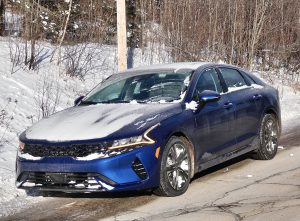
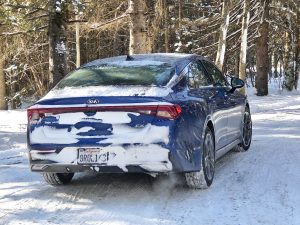
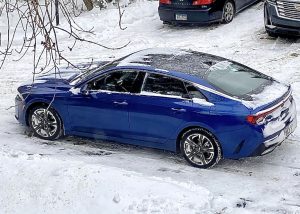
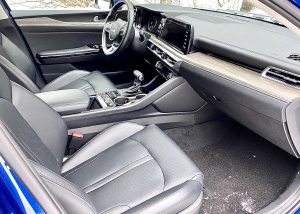
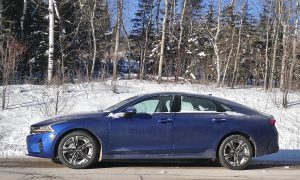
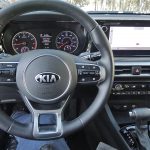
 John Gilbert is a lifetime Minnesotan and career journalist, specializing in cars and sports during and since spending 30 years at the Minneapolis Tribune, now the Star Tribune. More recently, he has continued translating the high-tech world of autos and sharing his passionate insights as a freelance writer/photographer/broadcaster. A member of the prestigious North American Car and Truck of the Year jury since 1993. John can be heard Monday-Friday from 9-11am on 610 KDAL(www.kdal610.com) on the "John Gilbert Show," and writes a column in the Duluth Reader.
John Gilbert is a lifetime Minnesotan and career journalist, specializing in cars and sports during and since spending 30 years at the Minneapolis Tribune, now the Star Tribune. More recently, he has continued translating the high-tech world of autos and sharing his passionate insights as a freelance writer/photographer/broadcaster. A member of the prestigious North American Car and Truck of the Year jury since 1993. John can be heard Monday-Friday from 9-11am on 610 KDAL(www.kdal610.com) on the "John Gilbert Show," and writes a column in the Duluth Reader.